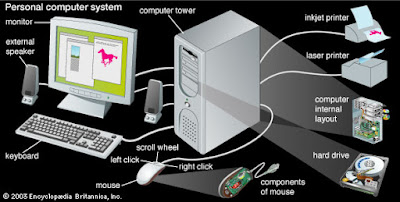 Following are the objective questions from Computer Fundamentals Section. Computer Fundamentals section includes the topics such as history of computers, generation of computers, classification of computers, Computer Peripherals, Storage Devices, Computer Security Systems, Computer Viruses, Computer Networking, System Analysis and Design and so on.
Following are the objective questions from Computer Fundamentals Section. Computer Fundamentals section includes the topics such as history of computers, generation of computers, classification of computers, Computer Peripherals, Storage Devices, Computer Security Systems, Computer Viruses, Computer Networking, System Analysis and Design and so on.1. Which of the following devices can be sued to directly image printed text?
a. OCR
b. OMR
c. MICR
d. All of above
2. The output quality of a printer is measured by
a. Dot per inch
b. Dot per sq. inch
c. Dots printed per unit time
d. All of above
3. In analog computer
a. Input is first converted to digital form
b. Input is never converted to digital form
c. Output is displayed in digital form
d. All of above
4. In latest generation computers, the instructions are executed
a. Parallel only
b. Sequentially only
c. Both sequentially and parallel
d. All of above
5. Who designed the first electronics computer – ENIAC?
a. Van-Neumann
b. Joseph M. Jacquard
c. J. Presper Eckert and John W Mauchly
d. All of above
6. Who invented the high level language c?
a. Dennis M. Ritchie
b. Niklaus Writh
c. Seymour Papert
d. Donald Kunth
7. Personnel who design, program, operate and maintain computer equipment refers to
a. Console-operator
b. Programmer
c. Peopleware
d. System Analyst
8. When did arch rivals IBM and Apple Computers Inc. decide to join hands?
a. 1978
b. 1984
c. 1990
d. 1991
9. Human beings are referred to as Homosapinens, which device is called Sillico Sapiens?
a. Monitor
b. Hardware
c. Robot
d. Computer
10. An error in software or hardware is called a bug. What is the alternative computer jargon for it?
a. Leech
b. Squid
c. Slug
d. Glitch
11. Modern Computer are very reliable but they are not
a. Fast
b. Powerful
c. Infallible
d. Cheap
12. What is the name of the display feature that highlights are of the screen which requires operator attention?
a. Pixel
b. Reverse video
c. Touch screen
d. Cursor
13. IMB launched its first personal computer called IBM-PC in 1981. It had chips from Intel, disk drives from Tandon, operating system from Microsoft, the printer from Epson and the application software from everywhere. Can you name the country which contributed the video display?
a. India
b. China
c. Germany
d. Taiwan
14. Personal computers use a number of chips mounted on a main circuit board. What is the common name for such boards?
a. Daughter board
b. Motherboard
c. Father board
d. Breadboard
15. In most IBM PCs, the CPU, the device drives, memory expansion slots and active components are mounted on a single board. What is the name of this board?
a. Motherboard
b. Breadboard
c. Daughter board
d. Grandmother board
16. What is meant by a dedicated computer?
a. Which is used by one person only
b. Which is assigned one and only one task
c. Which uses one kind of software
d. Which is meant for application software
17. The system unit of a personal computer typically contains all of the following except:
a. Microprocessor
b. Disk controller
c. Serial interface
d. Modem
18. A computer program that converts an entire program into machine language is called a/an
a. Interpreter
b. Simulator
c. Compiler
d. Commander
19. A computer program that translates one program instructions at a time into machine language is called a/an
a. Interpreter
b. CPU
c. Compiler
d. Simulator
20. A small or intelligent device is so called because it contains within it a
a. Computer
b. Microcomputer
c. Programmable
d. Sensor
MCQ Solution
ANS: 1. a. OCR/2. b. Dot per sq. inch/3. b. Input is never converted to digital form/4. c. Both sequentially and parallel/5. c. J. Presper Eckert and John W Mauchly/6. a. Dennis M. Ritchie/7. c. Peopleware/8. d. 1991/9. d. Computer/10. d. Glitch/11. c.Infallible/12. b. Reverse video/ 13. d. Taiwan/14. b. Motherboard/15. a. Motherboard/16. b. Which is assigned one and only one task/17. d. Modem/18. c. Compiler/
19. a. Interpreter/ 20. d. Sensor.







0 comments:
Post a Comment